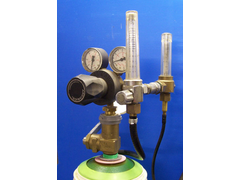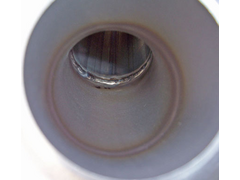AC-DC setting OK ?
Gas flow OK, not blocked ?
What happens if you make a weld pool without adding material ? (perhaps the adding material is not clean/same material as the stainless pipe ?)


I've startd having a go at welding some bits of stainless exhaust togethr and I seem to be getting a lot of crusty welds with a yellow/light
brown appearance. I figure it may have somethig to do with th Argon coverage. I have a rubber tube coming off a y splitter straight from the welder
output which I put into the exhaust pieces to back purge them but it was still there, though admittedly less.
Can anyone confirm if I'm right in what I'm thinking?
quote:
Originally posted by mistergrumpy
I've startd having a go at welding some bits of stainless exhaust togethr and I seem to be getting a lot of crusty welds with a yellow/light brown appearance. I figure it may have somethig to do with th Argon coverage. I have a rubber tube coming off a y splitter straight from the welder output which I put into the exhaust pieces to back purge them but it was still there, though admittedly less.
Can anyone confirm if I'm right in what I'm thinking?
No the crust is on top.
quote:
Originally posted by mistergrumpy
No the crust is on top.
Didn't de-grease it, just wire brushed it.
100% Argon, works fine with aluminium
Tungsten clean and sharp.
Sorry, I've never seen this kind of crusty weld on the weld pool side...
AC-DC setting OK ?
Gas flow OK, not blocked ?
What happens if you make a weld pool without adding material ? (perhaps the adding material is not clean/same material as the stainless pipe ?)

Its strange. When the current was too high it appeared worse but the current is under control now. The weld appears fine when welding but then when I stop welding it starts to yellow/brown.
You might as well list all the settings. Whats your flow rate, amperage, how is your torch set up, what grade is your filler?
Whenever I've seen that kind of welding its been due to incorrect gas flow or wrong gas (argoshield light)
In between dips are you pulling your filler rod out of the gas shielding? If you are it could be oxidising, this could explain the discoloration of the surface of the weld
IMHO
If I understand you correctly you have connected into the argon line to the torch that comes from the welder???
Neither flow is controllable done in this way. The gas will just take the easy path and as you weld up the joins then flow rate will change.
What you need is a Y or tee at the regulator with flow meters so you can control the individual flow rates.
e.g. 6 L/min purge, 9 L/min to the torch.
This will also enable you to purge for a couple of minutes before you start welding.
If I have misunderstood then ignore this post.
Cheers
Paul G


Rescued attachment 000_0545-s.jpg
No no that actually makes a lot of sense Paul. I have a tee on the welder output.
Regards the settings, I'll have to go outside later but I think Paul's right there plus I haven't been pre purging and from reading
last night I think I should have been plugging the open ends of the exhaust up with a small opening for venting pressure.
I'll have to try again later.
I'm sure the gas is fine it works well with aluminium and was sold as pure Argon.
Yes, you must block off the ends.
For 2" pipe I use a 2" disc of thin metal that has a hole in the middle ( 1/4" ) that is the same size as my purge tubing.
I push the tube through the disc and tape the disc to the end of the pipe to be welded.
The other end I block with a 2" disc that has a 3mm hole in it and tape this on.
If you have any gaps in any joints then 1" masking tape over the joint will stop you losing the argon.
Just peel off the tape for the joint to be welded, weld, then peel off the next one.
The inside should look like the one in the pic.
HTH
Cheers
Paul G


Rescued attachment Weld Pen s.jpg